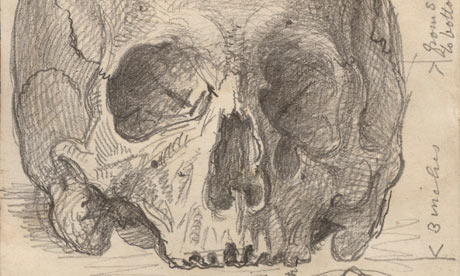Entre cientos de diarios y cuadernos de notas en cajas cerradas por años, había contenidos del ataúd del desventurado monarca, además de bosquejos de su cráneo y huesos.
Reuters
Publicado: 16/11/2010 14:13
Londres. Un archivero encontró reliquias de la tumba del rey medieval Ricardo II de Inglaterra mientras investigaba documentos del primer director de la Galería Nacional de Retratos, George Scharf, informó el martes la institución londinense.
Entre cientos de diarios y cuadernos de notas en cajas cerradas por años, había contenidos del ataúd del desventurado monarca, además de bosquejos de su cráneo y huesos.
Los contenidos de una caja de cigarrillos fechada el 31 de agosto de 1871 fueron identificados simplemente como reliquias de una tumba real cuando fue posible hallar las referencias a la fecha con entradas en el diario y dibujos hechos el mismo día.
La caja contenía fragmentos de madera, posiblemente del ataúd mismo y algo de tela.
Registros de la fecha muestran que Scharf estuvo presente en la apertura de las tumbas reales en la Abadía de Westminster y un trozo de cuero corresponde con su esbozo de un guante contenido en el ataúd.
Según la galería, una narración completa del evento fue registrada por el ilustrísimo reverendo Arthur Stanley, Decano de Westminster. Su relato fue publicado en 1879.
Scharf, quien también estuvo presente en la apertura de las tumbas de Ricardo II, Eduardo IV, Enrique VII, Jacobo I e Isabel de York, hizo dibujos del cráneo y los huesos de Ricardo II, incluyendo medidas detalladas.
"Fue un descubrimiento muy emocionante y uno que revela el potencial escondido de los documentos de Scharf", dijo Krzysztof Adamiec, archivador asistente de la galería, quien también trabaja en los documentos del antiguo director.
La galería dijo que la tumba del rey Ricardo II fue abierta en 1871 para limpieza, y que había tantos individuos presentes en el evento probablemente porque querían determinar si el rey fue asesinado por el golpe de un hacha.
El cráneo no mostró evidencias de ello.
Ricardo II gobernó del 1377 al 1399, cuando fue sucedido por Enrique IV. Muchos historiadores creen que murió de hambre durante su cautiverio en el 1400.
http://www.jornada.unam.mx/ultimas/2010/11/16/descubren-reliquias-de-la-tumba-del-rey-ricardo-ii-de-inglaterra
Richard II relics found in National Portrait Gallery archiveSkull drawings could be used to recreate true likeness of king who died in 1400 after being deposed by Henry IV
Mark Brown,

A sketch of a skull found among the Richard II relics at the National Portrait Gallery Photograph: National Portrait Gallery London
Researchers sifting the contents of long-unopened boxes at the National Portrait Gallery have discovered relics from the coffin of Richard II, along with detailed drawings of his skull which could be used to create a true likeness of the deposed medieval king.
To say the researchers were taken aback by the discovery in the archive of the gallery's founding director, Sir George Scharf, is perhaps an understatement.
"It was very surprising, yes," said Krzysztof Adamiec, the assistant archivist at the London gallery who made the discovery. The relics, he said, at first "just looked like a simple, empty box of cigarettes". He added: "But when I opened it up there were strips of leather and pieces of wood. It was very exciting for me – it's one of the biggest pleasures of this job to literally feel that you are touching history."
The wood is likely to be from Richard II's coffin, while there is compelling evidence that the leather is from his glove. There are also meticulously detailed sketches of the king's skull and bones, together with measurements which the gallery believes could be used to recreate a true likeness.
Scharf took charge of the gallery shortly after it was founded in 1857. After some detective work Adamiec was able to connect the relics in his archive with the decision in 1871 to open Richard's grave at Westminster Abbey.
The original intention was to clean the tombstones but, being inquisitive Victorians, those responsible decided that the coffin should be opened to try to establish how the king died in 1400 – after he was deposed by Henry IV – and whether it was because of an axe to the head. It wasn't.
Scharf, an enthusiastic witness, decided to pocket some mementoes, something which would be frowned upon now but was a "Victorian gentleman" thing to do. He was clearly a collector. Researchers have also found in the archive a pebble from the grave of Lord Macaulay, a piece of frame from a Raphael painting and the edge of a Van Dyck canvas.
The archive contains a huge amount of material, something like 230 notebooks and sketchbooks, which the gallery is about to complete cataloguing. Adamiec said: "He was a very meticulous man; he recorded everything. Every day he would make a note of the weather, which direction the wind blew, what he ate, who he met. Sometimes he would draw the table plans of dinners he attended."
Scharf, born in 1820, inherited his love of drawing from his father, who would take him on drawing expeditions, including one in 1834, to the ruins of the Palace of Westminster after the devastating fire, also documented in several paintings by JMW Turner. In 1854, he missed out on becoming director of the National Gallery but three years later was appointed secretary to the new NPG.
He was a prominent member of the Society of Antiquaries and seems to have particularly enjoyed grave openings, among them Richard II, Edward VI, Henry VII, James I and Elizabeth of York.
The Scharf archive catalogue is now available online, joining the papers of other gallery directors including Sir Lionel Cust and Sir Roy Strong.
guardian.co.uk
No hay comentarios:
Publicar un comentario